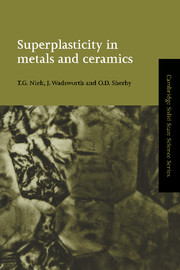Book contents
- Frontmatter
- Contents
- Preface
- Chapter 1 Introduction
- Chapter 2 Key historical contributions
- Chapter 3 Types of superplasticity
- Chapter 4 Mechanisms of high-temperature deformation and phenomenological relations for fine-structure superplasticity
- Chapter 5 Fine-structure superplastic metals
- Chapter 6 Fine-structure superplastic ceramics
- Chapter 7 Fine-structure superplastic intermetallics
- Chapter 8 Fine-structure superplastic composites and laminates
- Chapter 9 High-strain-rate superplasticity
- Chapter 10 Ductility and fracture in superplastic materials
- Chapter 11 Internal-stress superplasticity (ISS)
- Chapter 12 Other possible superplasticity mechanisms
- Chapter 13 Enhanced powder consolidation through superplastic flow
- Chapter 14 Superplastic forming and diffusion bonding
- Chapter 15 Commercial examples of superplastic products
- Index
Chapter 10 - Ductility and fracture in superplastic materials
Published online by Cambridge University Press: 15 October 2009
- Frontmatter
- Contents
- Preface
- Chapter 1 Introduction
- Chapter 2 Key historical contributions
- Chapter 3 Types of superplasticity
- Chapter 4 Mechanisms of high-temperature deformation and phenomenological relations for fine-structure superplasticity
- Chapter 5 Fine-structure superplastic metals
- Chapter 6 Fine-structure superplastic ceramics
- Chapter 7 Fine-structure superplastic intermetallics
- Chapter 8 Fine-structure superplastic composites and laminates
- Chapter 9 High-strain-rate superplasticity
- Chapter 10 Ductility and fracture in superplastic materials
- Chapter 11 Internal-stress superplasticity (ISS)
- Chapter 12 Other possible superplasticity mechanisms
- Chapter 13 Enhanced powder consolidation through superplastic flow
- Chapter 14 Superplastic forming and diffusion bonding
- Chapter 15 Commercial examples of superplastic products
- Index
Summary
We have discussed fine-structure superplasticity in various materials, including metals and ceramics, in Chapters 5–9. In these chapters, our discussions focused primarily on experimental observations, deformation mechanisms, and microstructural characteristics. Tensile ductility, which is determined by cavitation and fracture, was not emphasized. In this chapter, we will focus on the latter issue. A fracture mechanics model will be examined with available tensile elongation data for superplastic ceramics and superplastic intermetallics. The analysis permits a broad understanding of tensile elongation behavior of superplastic materials.
Tensile ductility in superplastic metals
It is well accepted that two competing processes govern the failure of superplastic materials at high temperature. One is related to macroscopic necking, and the other is related to microscopic cavitation and cracking. Macroscopic necking is governed by the strain-rate-sensitivity exponent, m, in the simplified constitutive equation σ=km, where σ is the true flow stress, is the true strain rate, and k is a material constant. A high m value usually indicates a diffuse neck development and, thus, a delay of the onset of tensile failure, which leads to high tensile elongations. The fracture profile of many superplastic metals with m≥0.4, however, reveals that there is no sharp pinpoint necking. This is because final fracture is caused by the evolution of cavities at grain boundaries, and in this sense, cavities lead to premature failure of test samples.
- Type
- Chapter
- Information
- Superplasticity in Metals and Ceramics , pp. 189 - 207Publisher: Cambridge University PressPrint publication year: 1997
- 2
- Cited by



